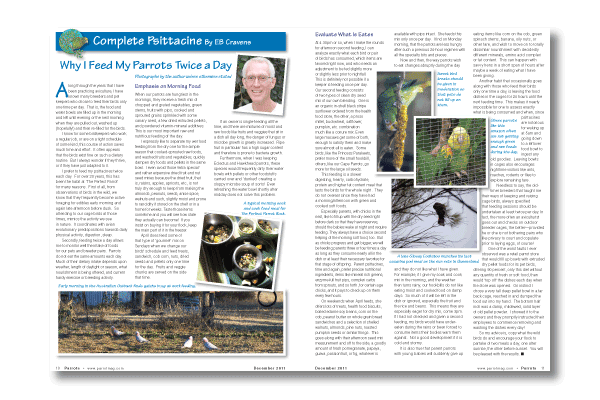
Why I Feed My Parrots Twice a Day
Along through the years that I have been practicing aviculture, I have known many breeders and pet keepers who chose to feed their birds only one time per day. That is, the food and water bowls are filled up in the morning and left until evening or the next morning when they are pulled out, washed up (hopefully!) and then re-filled for the birds.
I know for some birdkeepers who work a regular job, or are on a tight schedule of some kind, this course of action saves much time and effort. It often appears that the birds exist fine on such a dietary routine. But I always wonder if they thrive, or if they have just adapted to it.
I prefer to feed my psittacines twice each day. For over 20 years, this has been the habit at ‘The Perfect Parrot’ for many reasons. First of all, from observations of birds in the wild, we know that they frequently become active foraging for edibles early morning and again late afternoon before dusk. So attending to our cage birds at those times, mimics the activity we see in nature. It coordinates with avian evolutionary predispositions towards daily physical activity, digestion, sleep.
Read more in the magazine…
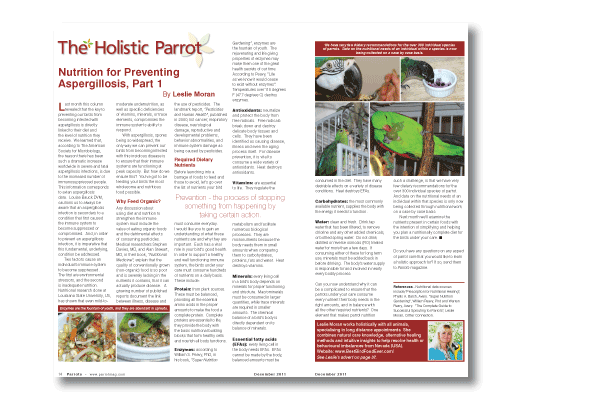
Nutrition for Preventing Aspergillosis, Part 1
Last month this column revealed that the key to preventing our birds from becoming infected with aspergillosis is directly linked to their diet and the level of nutrition they receive. We learned that, according to The American Society for Microbiology, the reason there has been such a dramatic increase worldwide in severe and fatal aspergillosis infections, is due to the increased number of immunosuppressed people. This information corresponds to avian aspergillosis data. Louise Bauck DVM, cautions us to always be aware that an aspergillosis infection is secondary to a condition that first caused the immune system to become suppressed or compromised. And, in order to prevent an aspergillosis infection, it is imperative that this fundamental, underlying, condition be addressed.
Two factors cause an individual’s immune system to become suppressed. The first are environmental stressors, and the second is inadequate nutrition. Nutritional research done at Louisiana State University, US, has shown that even mild-to-moderate undernutrition, as well as specific deficiencies of vitamins, minerals, or trace elements, compromises the immune system’s ability to respond.
Read more in the magazine…
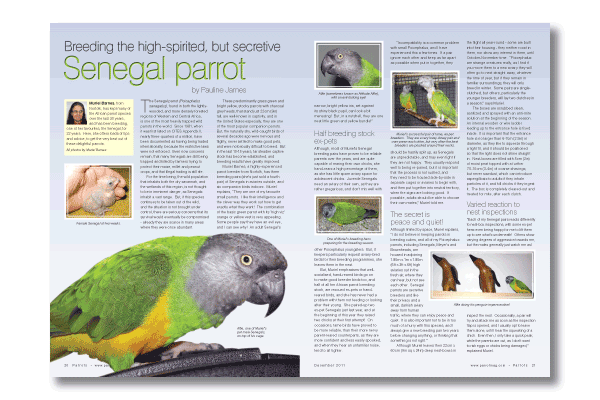
Breeding the high-spirited, but secretive Senegal parrot
by Pauline James
Muriel Barnes, from Norfolk, has kept many of the African parrot species over the last 30 years, and has been breeding, one of her favourites, the Senegal, for 22 years. Here, she offers loads of tips and advice, to get the very best out of these delightful parrots.
The Senegal parrot (Poicephalus senegalus), found in both the lightly-wooded, and more densely forested regions of Western and Central Africa, is one of the most heavily trapped wild parrots in the world. Since 1981, when it was first listed on CITES Appendix II, nearly three-quarters of a million, have been documented as having being traded internationally, because the restrictive laws were not enforced. Even now concerns remain, that many Senegals are still being trapped and killed by farmers trying to protect their maize, millet and peanut crops, and that illegal trading is still rife.
For the time being, the wild population that inhabits both the dry savannah, and the wetlands of this region, is not thought to be in imminent danger, as Senegals inhabit a vast range. But, if this species continues to be taken out of the wild, and the situation is not brought under control, there are serious concerns that its survival would eventually be compromised - already they are scarce in many areas where they were once abundant.
Read more in the magazine…
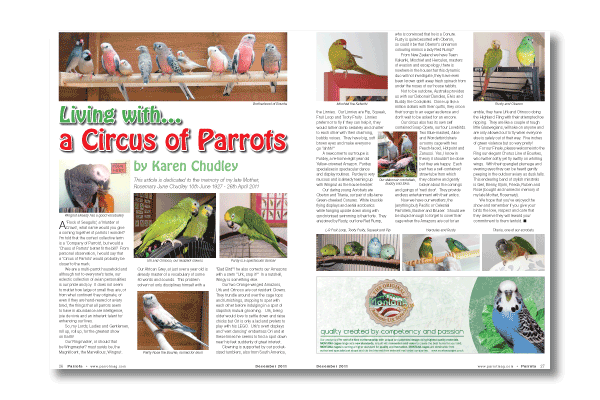
by Karen Chudley
This article is dedicated to the memory of my late Mother, Rosemary June Chudley 10th June 1927 - 26th April 2011.
A ‘Flock of Seagulls’, a ‘Murder of Crows’, what name would you give a coming together of parrots I wonder? I’m told that the correct collective term is a ‘Company of Parrots’, but would a ‘Chaos of Parrots’ better fit the bill? From personal observation, I would say that a ‘Circus of Parrots’ would probably be closer to the mark.
We are a multi-parrot household and although not to everyone’s taste, our eclectic collection of avian personalities is our pride and joy. It does not seem to matter how large or small they are, or from what continent they originate, or even if they are hand-reared or aviary bred, the things that all parrots seem to have in abundance are intelligence, joie de vivre and an inherent talent for enhancing our lives.
So, my Lords, Ladies and Gentlemen, roll up, roll up, for the greatest show on Earth!
Read more in the magazine…
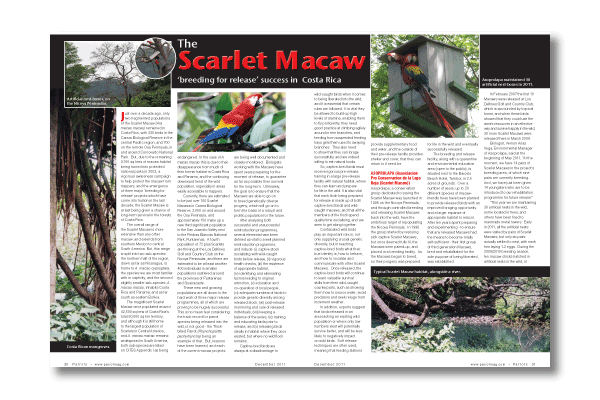
A success story from Costa Rica
Just over a decade ago, only two fragmented populations of the Scarlet Macaw (Ara macao macao) remained in Costa Rica, with 330 birds in the Carara Biological Reserve in the central Pacific region, and 700 on the remote Osa Peninsula, in and around Corcovado National Park. But, due to the remaining 9,100 sq kms of macaw habitat being turned into protected national parks in 2003, a vigorous awareness campaign to help protect the macaw from trappers, and the emergence of three major ‘breeding for release’ projects which have come into fruition in the last decade, the Scarlet Macaw is at last being given a chance of long-term survival in the forests of Costa Rica.
Read more in the magazine…





